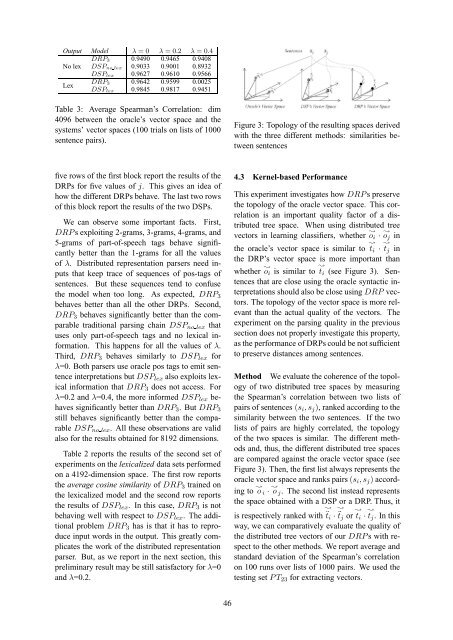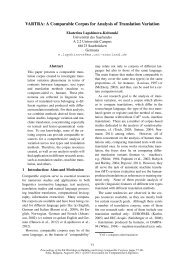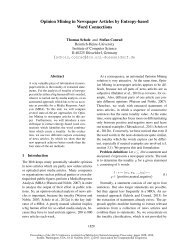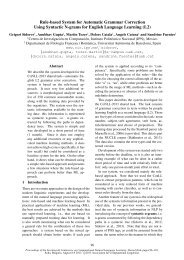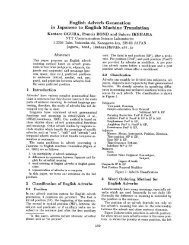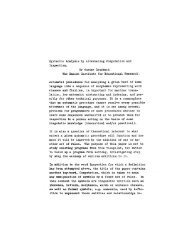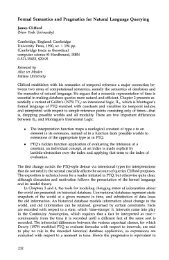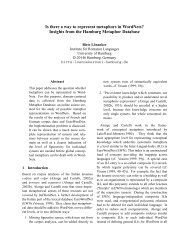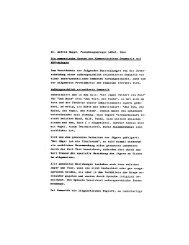Vector Space Semantic Parsing: A Framework for Compositional ...
Vector Space Semantic Parsing: A Framework for Compositional ...
Vector Space Semantic Parsing: A Framework for Compositional ...
You also want an ePaper? Increase the reach of your titles
YUMPU automatically turns print PDFs into web optimized ePapers that Google loves.
Output Model λ = 0 λ = 0.2 λ = 0.4<br />
DRP 3 0.9490 0.9465 0.9408<br />
No lex DSP lex no 0.9033 0.9001 0.8932<br />
DSP lex 0.9627 0.9610 0.9566<br />
Lex<br />
DRP 3 0.9642 0.9599 0.0025<br />
DSP lex 0.9845 0.9817 0.9451<br />
Table 3: Average Spearman’s Correlation: dim<br />
4096 between the oracle’s vector space and the<br />
systems’ vector spaces (100 trials on lists of 1000<br />
sentence pairs).<br />
Figure 3: Topology of the resulting spaces derived<br />
with the three different methods: similarities between<br />
sentences<br />
five rows of the first block report the results of the<br />
DRPs <strong>for</strong> five values of j. This gives an idea of<br />
how the different DRPs behave. The last two rows<br />
of this block report the results of the two DSPs.<br />
We can observe some important facts. First,<br />
DRP s exploiting 2-grams, 3-grams, 4-grams, and<br />
5-grams of part-of-speech tags behave significantly<br />
better than the 1-grams <strong>for</strong> all the values<br />
of λ. Distributed representation parsers need inputs<br />
that keep trace of sequences of pos-tags of<br />
sentences. But these sequences tend to confuse<br />
the model when too long. As expected, DRP 3<br />
behaves better than all the other DRPs. Second,<br />
DRP 3 behaves significantly better than the comparable<br />
traditional parsing chain DSP no lex that<br />
uses only part-of-speech tags and no lexical in<strong>for</strong>mation.<br />
This happens <strong>for</strong> all the values of λ.<br />
Third, DRP 3 behaves similarly to DSP lex <strong>for</strong><br />
λ=0. Both parsers use oracle pos tags to emit sentence<br />
interpretations butDSP lex also exploits lexical<br />
in<strong>for</strong>mation that DRP 3 does not access. For<br />
λ=0.2 and λ=0.4, the more in<strong>for</strong>med DSP lex behaves<br />
significantly better than DRP 3 . But DRP 3<br />
still behaves significantly better than the comparable<br />
DSP no lex . All these observations are valid<br />
also <strong>for</strong> the results obtained <strong>for</strong> 8192 dimensions.<br />
Table 2 reports the results of the second set of<br />
experiments on the lexicalized data sets per<strong>for</strong>med<br />
on a 4192-dimension space. The first row reports<br />
the average cosine similarity of DRP 3 trained on<br />
the lexicalized model and the second row reports<br />
the results of DSP lex . In this case, DRP 3 is not<br />
behaving well with respect to DSP lex . The additional<br />
problem DRP 3 has is that it has to reproduce<br />
input words in the output. This greatly complicates<br />
the work of the distributed representation<br />
parser. But, as we report in the next section, this<br />
preliminary result may be still satisfactory <strong>for</strong>λ=0<br />
and λ=0.2.<br />
4.3 Kernel-based Per<strong>for</strong>mance<br />
This experiment investigates how DRP s preserve<br />
the topology of the oracle vector space. This correlation<br />
is an important quality factor of a distributed<br />
tree space. When using distributed tree<br />
vectors in learning classifiers, whether o ❀ i · ❀o j in<br />
the oracle’s vector space is similar to ❀ t i · ❀<br />
t j in<br />
the DRP’s vector space is more important than<br />
whether ❀ o i is similar to ❀ t i (see Figure 3). Sentences<br />
that are close using the oracle syntactic interpretations<br />
should also be close usingDRP vectors.<br />
The topology of the vector space is more relevant<br />
than the actual quality of the vectors. The<br />
experiment on the parsing quality in the previous<br />
section does not properly investigate this property,<br />
as the per<strong>for</strong>mance of DRPs could be not sufficient<br />
to preserve distances among sentences.<br />
Method We evaluate the coherence of the topology<br />
of two distributed tree spaces by measuring<br />
the Spearman’s correlation between two lists of<br />
pairs of sentences (s i ,s j ), ranked according to the<br />
similarity between the two sentences. If the two<br />
lists of pairs are highly correlated, the topology<br />
of the two spaces is similar. The different methods<br />
and, thus, the different distributed tree spaces<br />
are compared against the oracle vector space (see<br />
Figure 3). Then, the first list always represents the<br />
oracle vector space and ranks pairs(s i ,s j ) according<br />
to ❀ o i · ❀o<br />
j . The second list instead represents<br />
the space obtained with a DSP or a DRP. Thus, it<br />
is respectively ranked with<br />
❀ẗi ·<br />
❀ẗj or ❀ t i · ❀<br />
t j . In this<br />
way, we can comparatively evaluate the quality of<br />
the distributed tree vectors of our DRP s with respect<br />
to the other methods. We report average and<br />
standard deviation of the Spearman’s correlation<br />
on 100 runs over lists of 1000 pairs. We used the<br />
testing set PT 23 <strong>for</strong> extracting vectors.<br />
46


